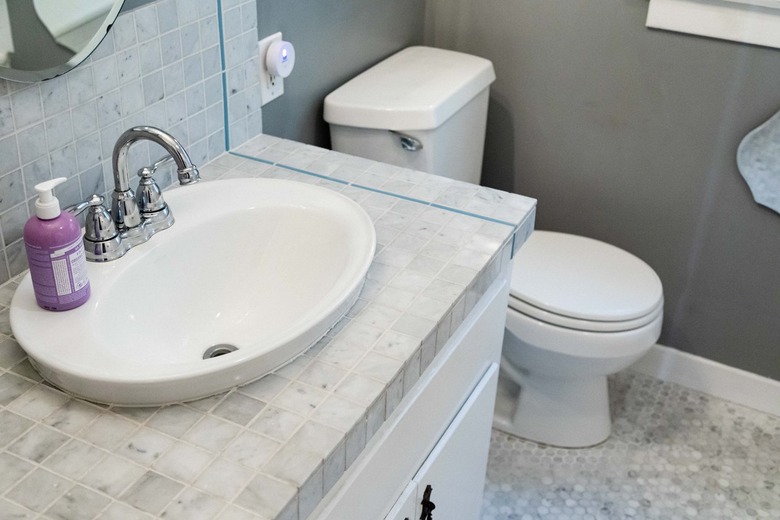A DIY Guide To Toilet Flange Repair
A key component to a toilet installation is a part that is rarely seen — the toilet flange. Though you may never need to repair or replace one, on the rare occasion when it does fail, toilet flange repair becomes an urgent project.
Made of plastic or metal, the toilet flange sits beneath the base of the toilet, providing an anchor point to keep it solidly in place on the floor. It is also critical to the watertight seal between the toilet and the floor drain opening. Although it costs only $20 to $30, the toilet flange is still one of the most important parts of bathroom plumbing. Fortunately, toilet flange repair is both inexpensive and easy.
Function of the Toilet Flange
The toilet flange fitting, usually made of plastic or sometimes cast iron, consists of a flat circular outer bolt rail attached to a hollow tubular insert that fits down into the toilet drain opening in the floor. The flange is secured to the floor with screws driven down through the outer bolt rail and into the subfloor. The bolt rail has slotted openings into which upward-facing toilet bolts (called closet bolts) are inserted. A wax ring seal is then positioned around the drain opening.
The toilet itself is then rested onto the flange and wax ring with its drain horn fitting down into the drain opening and with the closet bolts extending up through openings in the base of the toilet. As the last step, mounting nuts are threaded onto the bolts and tightened down, which further compresses the wax ring and holds the toilet base securely to the floor.
Symptoms of Toilet Flange Problems
When properly installed, a toilet flange can last for many decades, although the wax ring seal between the flange and the toilet may need to be replaced periodically. The toilet flange will continue to work properly as long as it remains firmly anchored against the floor and as long as the seal between the flange and the toilet remains intact.
The common symptoms of a toilet flange that needs repair or replacement are when the toilet begins to rock against the floor or when you notice drain water seeping around the base of the toilet during or immediately after a flush. The rocking usually occurs because the outer bolt rail on the flange has cracked, and the toilet bolts can no longer hold the toilet securely against the floor. This is a more common problem with ABS or PVC toilet flanges since the hard plastic is somewhat brittle. Old metal flanges, however, can fail due to corrosion.
While a small amount of rocking might seem like a minor thing, it is no small issue. A slight rocking of the toilet can break the seal around the toilet drain, and even a small amount of water leaking around the toilet drain can rot out the subfloor over time and lead to a much bigger structural problem. Fortunately, there are a variety of inexpensive products that can help you restore the toilet flange (and the toilet) to good working order.
There are four common toilet problems that are directly or indirectly related to the toilet flange:
- Bad wax ring
- Broken or cracked toilet flange
- Rotten, sagging subfloor
- Toilet flange too low
A Failing Toilet Wax Ring
Although it is not technically a part of the toilet flange, the wax ring seal that fits between the toilet floor drain and the porcelain drain outlet (the horn) on the toilet is probably more likely to fail than the flange itself. As noted by PlumbingSupply.com, over time, the wax that seals the bottom of the toilet drain against the drain opening can get compressed or cracked. With this seal compromised, drain water can seep out around the base of the toilet during a flush.
The same symptom can sometimes indicate that the toilet flange is broken, and you probably won't know the real cause of the problem until you remove the toilet and inspect the toilet flange and wax ring. However, if a toilet that leaks around the base still seems solidly anchored to the floor, it's likely that the problem lies with the wax ring rather than the toilet flange.
Broken or Cracked Toilet Flange
If a toilet rocks in place and does not sit tight on the floor with or without leaking around the base, it is likely that the toilet flange is broken. When this happens, the closet bolts that connect to the flange can no longer hold the toilet in place, and this allows the toilet to rock unsteadily. The fix is to replace the entire toilet flange or to use a repair kit to reinforce the broken bolt rail.
Sometimes, a small amount of rocking can occur simply because the wax ring is becoming compressed from long use. Try tightening the bolts that hold the toilet to the floor. If this tightening eliminates the rocking, then the toilet flange is probably still intact. The wax ring should be replaced fairly soon. If tightening the bolts does not eliminate the rocking, then it's almost certain that the toilet flange is broken.
Rotten, Sagging Subfloor
Some of the same symptoms of a broken toilet flange can occur if the subfloor beneath the toilet has begun to rot and sag. This may cause the toilet to rock in place as the subfloor bends under weight. The best fix is to remove the toilet and perform structural work to replace the bad section of subfloor.
Subfloor repair is a fairly major job that may require the work of a carpenter or a very skilled DIYer. There are also repair kits available that allow you to temporarily reinforce the soft subfloor area around a toilet with a rigid plate. This should be regarded as a temporary solution, however, since once wood rot starts, it will spread and affect the surrounding wood.
Toilet Flange Is Too Low
In the ideal installation, the outer edge of the toilet flange rests directly on a finished flooring surface that butts right up to the edges of the drain opening. Drain flanges and toilets are configured so that this allows just the right amount of space for the wax ring to fit between the toilet flange and the toilet.
Sometimes, however, bathroom remodelers install new, thicker flooring material over the old flooring up to the edge of the existing toilet flange but without removing the flange and installing the new flooring beneath it. As a result, the toilet flange sits recessed below the level of the surrounding new flooring. The gap between the flange and toilet may now be too wide to be sealed by the wax ring, and as a result, the toilet may leak around the base. Several types of flange extension kits are available that allow you to raise the flange to the proper height. These are generally quite easy for DIYers to install.
Toilet Flange Repair Products
A variety of products are available to simplify the task of repairing or replacing a toilet flange. Most of these are available at home improvement centers and hardware stores as well as online retailers. Doing the work yourself will safe you a considerable amount of money over the cost of having a plumber do the work.
Professional plumbers average $70 to $100 per hour, and you can count on a minimum of two hours of labor for any of these repairs. Since the cost of the repair products are quite modest, the potential cost savings for DIYers is substantial. Typical material costs are $5 to $10 for a wax ring, $5 to $30 for a replacement toilet flange, around $30 for a toilet flange repair kit, $20 to $30 for a toilet flange extension kit, $10 to $20 for a toilet flange floor support and around $100 for a toilet flange removal tool.
Wax ring: A replacement wax ring may be the only thing you need when a toilet leaks around the base but is otherwise well-anchored to the floor. The wax ring features a plastic cone that fits down into the drain opening, surrounded by a thick wax ring that seals between the toilet drain opening and the toilet flange. Replacing the wax ring is messy but not at all difficult. There are also synthetic foam gaskets that do the same job as a wax ring but are much less messy.
New toilet flange: If a toilet flange does break or crack, there are many replacement options available. In modern installations, it is most common to use PVC or ABS plastic toilet flanges, but there are also cast iron flanges available if you have an older installation with a cast iron toilet drain pipe. There are also toilet flanges that feature a stainless steel outer bolt rail secured around a PVC plastic body. Toilet flanges generally come in 3-inch or 4-inch sizes to match the size of your toilet drain pipe. The toilet flange often comes in a kit that includes additional parts, including the wax ring, closet bolts and bolt caps.
Installing a new toilet flange involves removing the toilet, scraping away the wax ring and removing the old toilet flange and then installing a new flange and wax ring over the drain opening. The flange can be connected to the drain pipe in a number of different ways depending on the type of flange. Some PVC and ABS flanges are designed to be joined to the drain pipe with solvent glue, while others have a friction-fit gasket that makes a tight seal when the flange is forced down into the drain pipe.
Toilet flange repair kit: When a toilet flange with a broken bolt rail is difficult to remove from the drain pipe, consider using a repair kit. The repair kit consists of a metal ring that bolts around an existing flange to create a new anchor point for the closet bolts. This solution may slightly change the height of the flange, however, so it should be used only when removing the old flange is not a practical option.
Toilet flange extension kit: These kits are designed to raise the height of a flange to accommodate the thickness of new flooring that has been installed up to but not under the current flange. The extension kit is essentially a new flange that fits atop the old flange to raise the height. The kit includes a variety of spacers that let you adjust the height of the flange to match your needs.
However, most drain extensions include an outlet that fits inside the old flange, which effectively reduces the diameter of the drain opening. This reduced drain opening may increase the likelihood of drain clogs. So, when possible, it's still best to remove the old flange and replace it. When this is difficult, however, such as when the old flange is solvent-glued in place, a flange extension offers a good solution.
Closet flange floor support: When the floor around the toilet is rotting or sagging, the best solution is structural work to replace the bad subflooring. This process involves removing the old toilet and flange and then cutting away and replacing the plywood subfloor around the toilet area. When this isn't practical, you can consider a closet flange floor support.
The floor support is a thin, rigid plate that fits around the flange to reinforce the floor beneath the toilet. Installation involves removing the toilet and placing the flange floor support around the flange and over the sagging floor. When the toilet is reinstalled, the floor is stiffened and no longer sags beneath the toilet. This is a temporary fix, however, and sooner or later, the rotting subfloor will need to be addressed.
Flange removal tool: Toilet flanges that have been solvent-glued in place can be hard to remove when replacement is needed. A flange removal tool is essentially a large hole saw with a center guide. When mounted in a power drill, the saw grinds through the edges of the solvent-glued joint, leaving the drain opening ready to accept a new toilet flange. This is a fairly expensive accessory that is normally owned only by professional plumbers, though serious DIYers can certainly use it.


